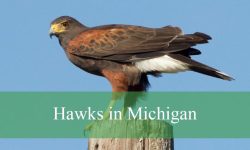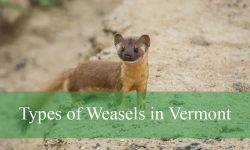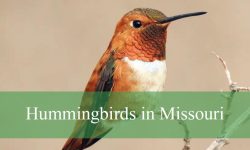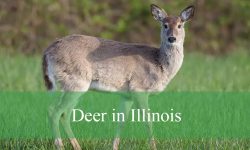Sparrows in Nebraska are a diverse and fascinating group of birds that bring subtle beauty and lively songs to fields, wetlands, forests, and neighborhoods across the state. Though many sparrows share similar brown-and-gray tones, each species has distinct features, behaviors, and vocalizations that make them stand out upon closer observation.
Nebraska’s central location along major migratory routes makes it a prime region for spotting a wide variety of sparrows throughout the seasons. Some species, like the Harris’s Sparrow, are unique to the Great Plains, while others such as the Savannah Sparrow and Song Sparrow are more widespread but equally important to the local ecosystem.
This guide introduces 29 species of sparrows in Nebraska, complete with identification tips, songs, feeding habits, and habitat preferences. From secretive grassland dwellers to bold backyard visitors, these sparrows reflect the rich biodiversity found across the state.
Common Sparrows in Nebraska
Cassin’s Sparrow (Peucaea cassinii)

Cassin’s Sparrow is a subtle but elegant bird with pale grayish-brown plumage, fine streaking on its head and back, and a plain gray breast. Its overall appearance is modest, blending easily into dry grasslands and shrublands. It is best identified by its flat-headed profile and slightly long tail with a rounded tip.
This sparrow is known for its skylarking behavior—males often launch into the air to sing and then parachute slowly back to the ground while delivering a sweet, musical trill. Their song is a soft, descending series of notes, especially prominent during the breeding season. They are generally quiet and elusive outside of singing displays.
In Nebraska, Cassin’s Sparrow is considered an occasional or locally common summer visitor in the far southwestern parts of the state, especially in arid grasslands or open areas with scattered shrubs. They feed mainly on insects and seeds and prefer undisturbed habitats, often avoiding heavily grazed or developed areas.
Grasshopper Sparrow (Ammodramus savannarum)
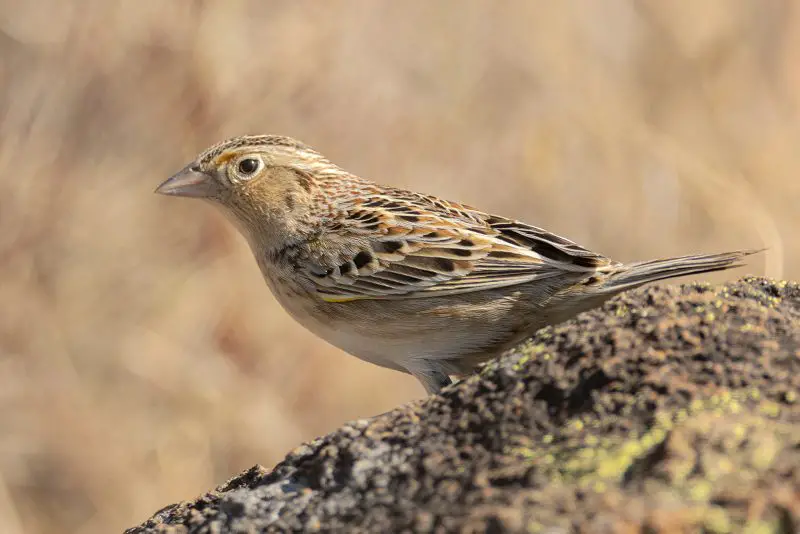
The Grasshopper Sparrow is a small, chunky bird with a large head, short tail, and a flat crown. Its plumage is mostly buffy with fine streaks on the back and a distinct orange-yellow patch in front of each eye. Its pale underparts and clear breast help differentiate it from other streaky sparrows.
This species is named for its insect-like song, a thin, high-pitched buzz that sounds much like a grasshopper’s call. It is more often heard than seen, as it tends to stay low in the grass and flushes reluctantly when approached. Males sing from low perches during the breeding season to mark territory.
Grasshopper Sparrows are summer residents in Nebraska’s native prairies, pastures, and open fields. They feed heavily on insects during the breeding season and switch to seeds in fall and winter. Populations have declined in areas where grassland habitats have been fragmented or lost due to agriculture.
Black-throated Sparrow (Amphispiza bilineata)

The Black-throated Sparrow is a striking desert species, easily recognized by its bold facial pattern and black throat patch. Its gray upperparts, white underparts, and white eyebrow and mustache stripes contrast sharply with its jet-black bib, making it one of the most distinctive sparrows in North America.
Unlike many other sparrows, this species has a clear, bell-like song composed of short, sweet notes that can carry across arid landscapes. It also makes high-pitched call notes that help keep flocks together. The bird often perches on shrubs or rocks to sing, especially early in the morning.
In Nebraska, the Black-throated Sparrow is an accidental visitor, recorded only rarely in the far southwest or during unusual migration events. Its primary habitat includes arid scrublands and rocky deserts in the southwestern U.S. and Mexico, where it feeds mostly on seeds and small insects.
Lark Sparrow (Chondestes grammacus)
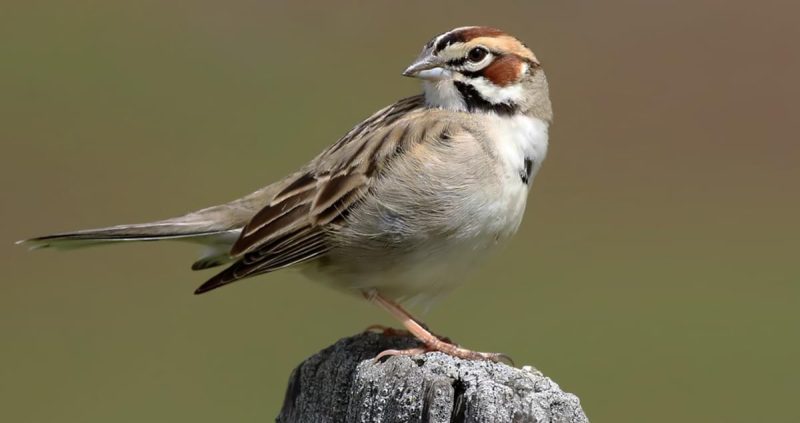
The Lark Sparrow is a large and handsome sparrow with a boldly patterned head featuring chestnut cheek patches, a central crown stripe, and a white face. Its body is light brown with a white belly and a dark central breast spot. When flying, its broad white tail corners and fluttery flight make it easy to recognize.
This species has a unique, musical song—a mix of trills, whistles, and buzzes. It often incorporates mimicry and pauses between phrases, making it more complex than typical sparrow songs. Males perform aerial displays during courtship, flying upward and gliding down with fluttering wings.
Lark Sparrows are widespread summer residents across open areas in Nebraska, especially in grasslands, agricultural fields, and areas with scattered shrubs or trees. They nest on the ground or in low shrubs and forage on seeds and insects. They are relatively adaptable and thrive in disturbed habitats.
Lark Bunting (Calamospiza melanocorys)
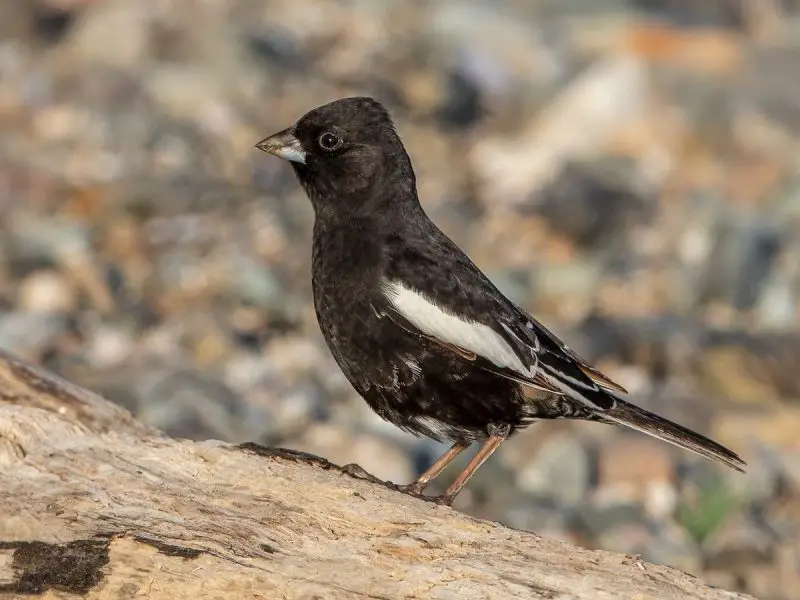
The Lark Bunting is the state bird of Colorado but is also frequently seen in western and central Nebraska during summer. Males are unmistakable in breeding plumage with their glossy black bodies and large white wing patches. Females and nonbreeding males are streaked brown, resembling other sparrows but still identifiable by size and posture.
Their song is a cheerful, warbled melody delivered in flight, with males rising into the air and singing as they descend slowly back to earth. This aerial performance is key during the mating season. Outside of breeding, they gather in large flocks and are generally quiet and unobtrusive.
Lark Buntings breed in Nebraska’s shortgrass prairies, mixed-grass regions, and sandy areas with sparse vegetation. They feed mainly on insects during summer and shift to seeds in the nonbreeding season. Though still fairly common, their numbers have declined due to habitat loss and changes in prairie land use.
Chipping Sparrow (Spizella passerina)
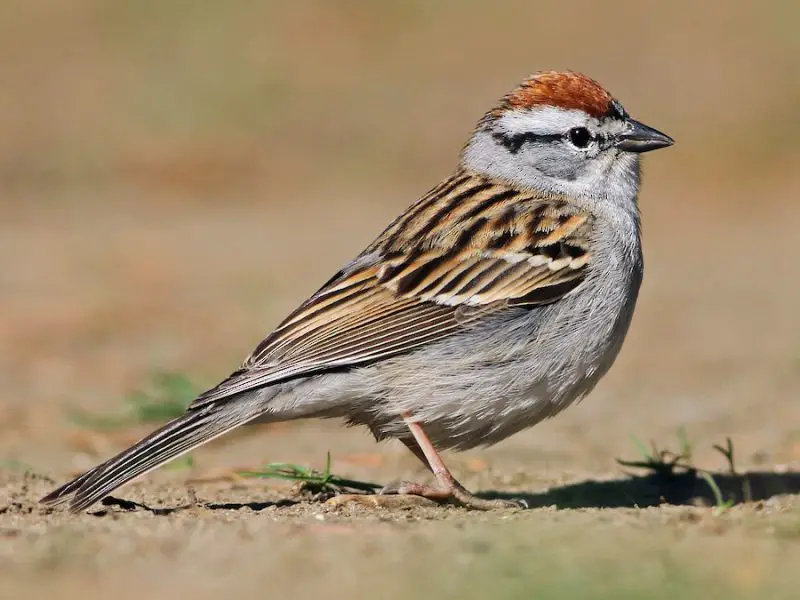
The Chipping Sparrow is a small, slender bird with a clean, crisp appearance. Adults are easy to recognize by their rusty-red crown, black eye line, and pale gray underparts. Their back is brown with fine streaking, and they have a sharply notched tail. Juveniles lack the distinct head pattern and appear more streaked overall.
This species has a fast, mechanical trill for a song, often compared to the sound of a sewing machine. Chipping Sparrows are highly active, often seen flitting through shrubs, hopping on the ground, or feeding in flocks outside the breeding season. They are not particularly shy and readily visit backyard feeders.
In Nebraska, Chipping Sparrows are widespread summer residents across woodlands, open fields, parks, and suburban areas. They nest in shrubs or low trees and feed primarily on seeds and small insects. Their adaptability to human-altered landscapes has made them one of the most common sparrows in the state.
Clay-colored Sparrow (Spizella pallida)
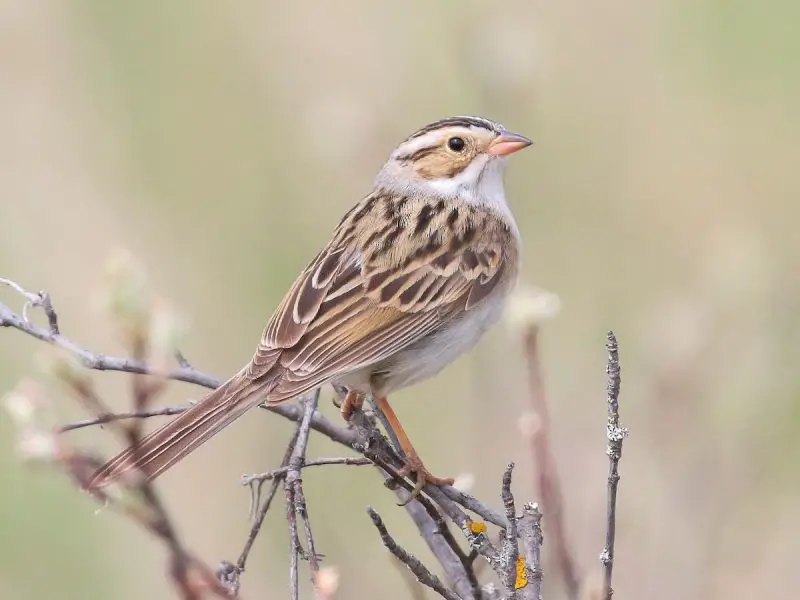
The Clay-colored Sparrow is a small, pale sparrow with a distinctive face pattern, including a gray nape, buffy eyebrow, and dark eye line. Its back is streaked brown, while the underparts are plain and pale. This subtle combination of field marks sets it apart from similar-looking species.
Its song is a dry, insect-like buzz, often described as a long, monotonous “bzzzzzz.” Males sing from exposed perches during the breeding season and are often more easily heard than seen. Outside of singing, the bird tends to stay low in shrubs or grass, where it forages quietly.
In Nebraska, Clay-colored Sparrows are common summer residents, particularly in the northern and central regions. They prefer shrubby grasslands, prairie edges, and young shelterbelts for nesting. Their diet consists mainly of seeds, though they also eat insects during the breeding season.
Field Sparrow (Spizella pusilla)
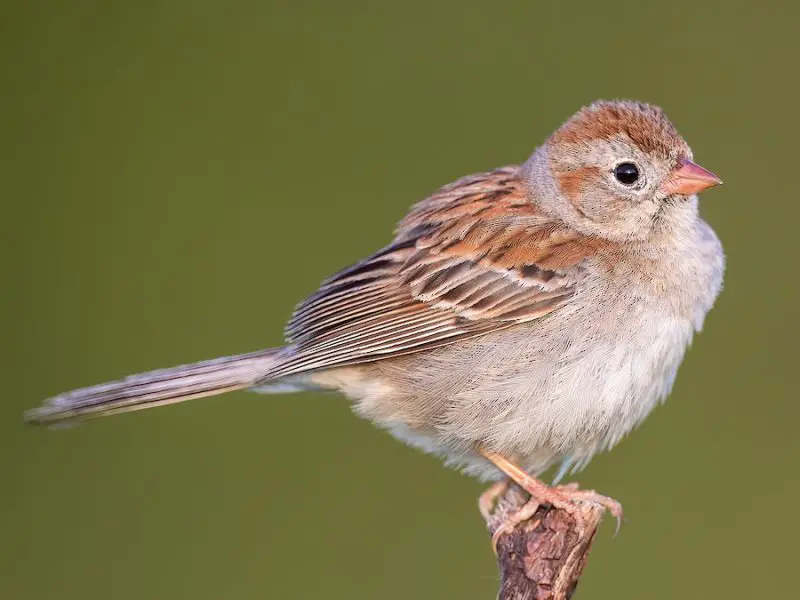
The Field Sparrow is a dainty, pale sparrow with a pink bill, plain face, and warm rufous tones on the crown and behind the eye. Its body is a soft mix of gray and buff, and it lacks the strong facial markings found in many other sparrows. The tail is relatively long and notched.
Its song is a distinctive accelerating series of whistles, often likened to the sound of a bouncing ball coming to a stop. These birds are shy but persistent singers, especially at dawn and dusk during spring and summer. They spend much of their time foraging on the ground and are usually seen singly or in pairs during breeding.
Field Sparrows are summer residents throughout much of Nebraska, favoring weedy fields, grasslands, and brushy areas. They build nests close to the ground and feed on seeds, grass, and insects. This species is sensitive to habitat loss and declines where old fields are converted or overgrazed.
Brewer’s Sparrow (Spizella breweri)

Brewer’s Sparrow is a small, unassuming bird with gray-brown plumage and fine streaking on its back. Its face is plain, with a faint eye ring and subtle facial contrast. It lacks bold head patterns, making it one of the more difficult sparrows to identify by sight alone.
Despite its drab appearance, the Brewer’s Sparrow has a complex, melodious song composed of varied trills and whistles. Males sing persistently from low shrubs or fences during the breeding season. This sparrow prefers to remain hidden in dense brush, particularly when not singing.
In Nebraska, Brewer’s Sparrow is a rare and local visitor, typically found in the extreme western part of the state during migration or occasionally in summer. It prefers sagebrush steppe and arid shrublands in its core range. Its diet includes insects in summer and seeds during other seasons.
Fox Sparrow (Passerella iliaca)
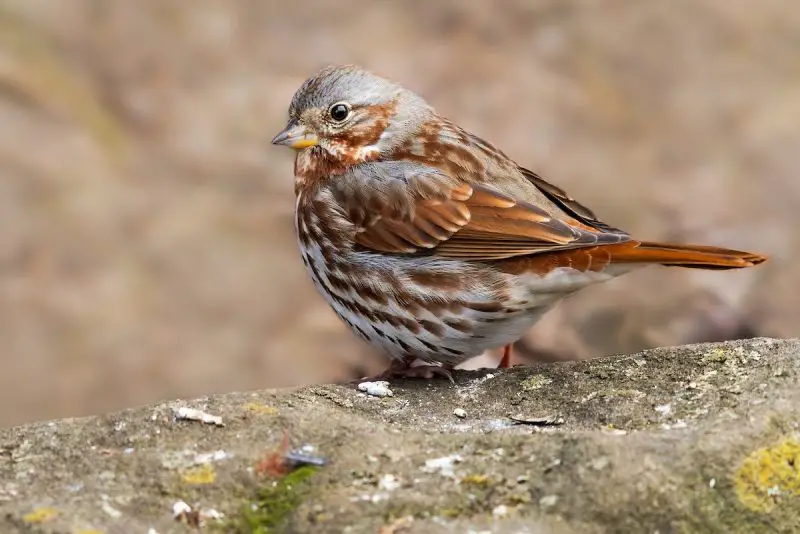
The Fox Sparrow is one of the largest and most richly colored sparrows in North America. It has a stout body, heavily streaked chest, and a bright rufous tail. Plumage color varies by region, but in Nebraska, the red (taiga) form with reddish-brown upperparts and streaked underparts is most common.
This bird has a sweet, rich song of whistled phrases, similar to that of a thrush. It also gives sharp “chip” calls when alarmed. Fox Sparrows are strong ground foragers and use a double-scratch motion to uncover food, flipping leaves and debris as they search for insects and seeds.
In Nebraska, Fox Sparrows are primarily seen during migration in spring and fall. They favor thickets, wooded edges, and dense understory during stopovers. Although they breed farther north and west, they are regular transients across much of the state, particularly in riparian areas.
American Tree Sparrow (Spizelloides arborea)
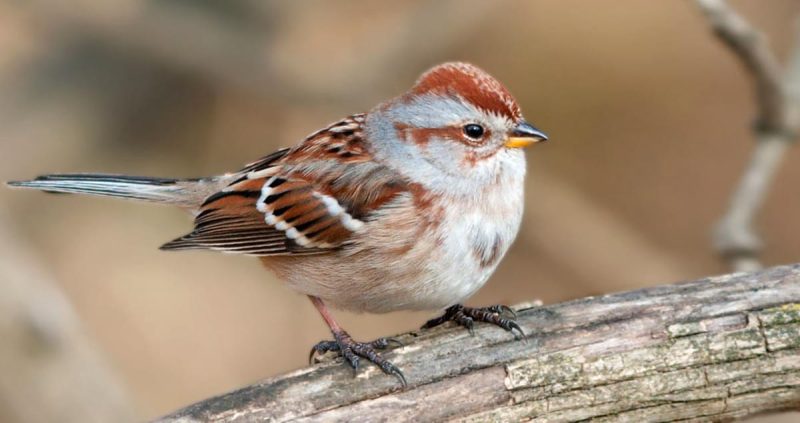
The American Tree Sparrow is a medium-sized sparrow with a rusty cap, a gray face, and a distinct dark spot in the center of its pale breast. It has a slender bicolored bill—dark above and yellow below—and rusty streaks on its back and flanks. Its tail is long and notched, typical of sparrows.
This species has a sweet, musical song composed of clear whistles and trills. Outside the breeding season, it forms flocks and is often seen foraging on the ground or perched in low shrubs. Tree Sparrows are active, frequently flicking their tails and feeding in weedy fields and brushy edges.
In Nebraska, American Tree Sparrows are winter residents, arriving in late fall and staying through early spring. They prefer open habitats such as prairies, agricultural fields, and woodland edges, especially where seed sources are abundant. Their diet includes seeds, grass, and small insects when available.
Dark-eyed Junco (Junco hyemalis)

The Dark-eyed Junco is a familiar winter bird across Nebraska. It is small and plump, with a rounded head, short pink bill, and white outer tail feathers. The most common form in Nebraska is the “Slate-colored” Junco, which has dark gray upperparts and a pale belly, giving it a clean two-toned appearance.
Juncos produce short, musical trills and high-pitched “tick” calls that are easy to recognize. They are highly social in winter, often seen in flocks foraging on the ground beneath feeders, shrubs, or trees. They hop rather than walk and show flashes of white tail feathers in flight.
These birds breed in coniferous forests far to the north or in the mountains, but in Nebraska, they are common winter visitors across all habitats—woodlands, towns, grasslands, and backyard feeders. Their diet is primarily seeds, with occasional insects in warmer months or milder periods.
White-crowned Sparrow (Zonotrichia leucophrys)
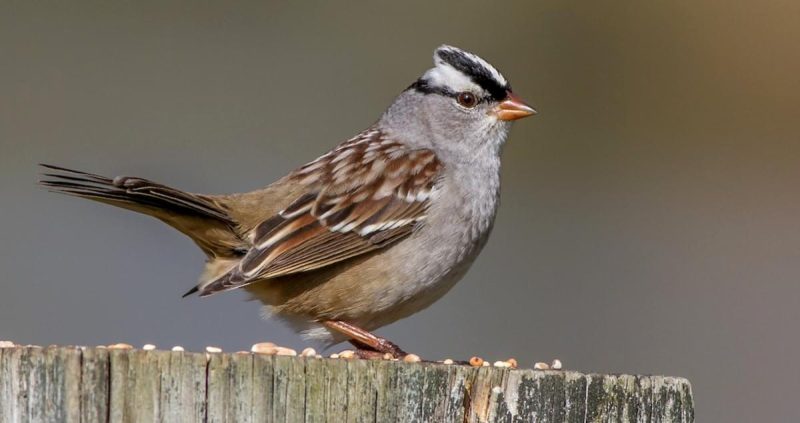
The White-crowned Sparrow is a large and striking sparrow with bold black-and-white stripes on its head, a plain gray face, and a pink or yellowish bill. Its body is mostly gray with brown-streaked wings and a long tail. Immature birds have brown and tan stripes instead of the adult’s crisp black and white.
This sparrow sings a clear, whistled song that varies regionally but typically begins with a few high notes followed by a series of sweet whistles and trills. It is often found in loose flocks during migration or winter, feeding on the ground in weedy areas and hedgerows.
In Nebraska, White-crowned Sparrows are common migrants in spring and fall and occasionally overwinter in the southern parts of the state. They inhabit brushy areas, thickets, field edges, and even gardens. Their diet consists of seeds, buds, berries, and some insects during migration.
Golden-crowned Sparrow (Zonotrichia atricapilla) — Accidental
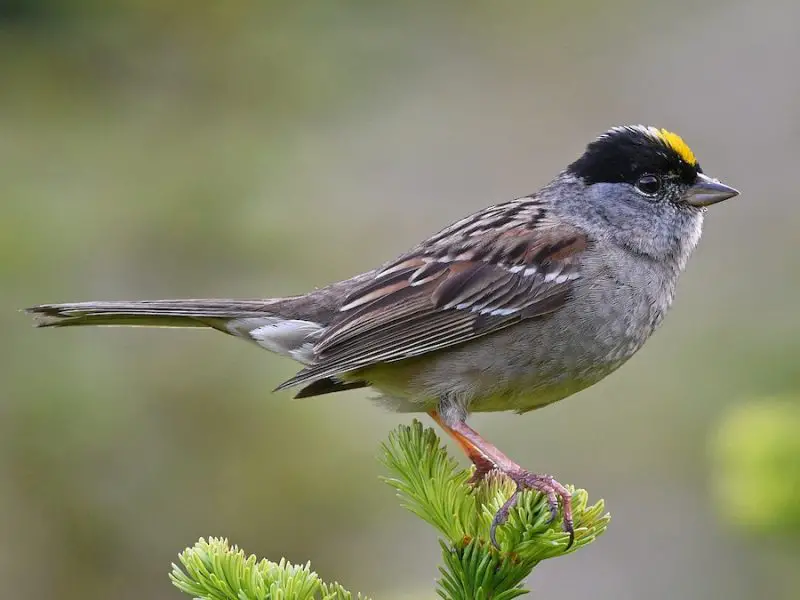
The Golden-crowned Sparrow is a large, handsome sparrow rarely seen in Nebraska. Adults have a distinctive golden-yellow forehead bordered by black crown stripes, while immature birds have a duller, less contrasting crown. Their body is grayish with brown wings and a relatively long tail.
Their song is a slow, plaintive series of three descending notes, often described as sounding sad or mournful. This species is often found in loose flocks during migration or winter, foraging quietly in brushy areas. They can be shy and are often seen on or near the ground.
In Nebraska, the Golden-crowned Sparrow is considered an accidental or rare visitor, with very few records. Its normal range lies along the Pacific Coast, where it breeds in Alaska and winters in the western United States. Sightings in Nebraska typically occur during migration and are usually brief.
Harris’s Sparrow (Zonotrichia querula)
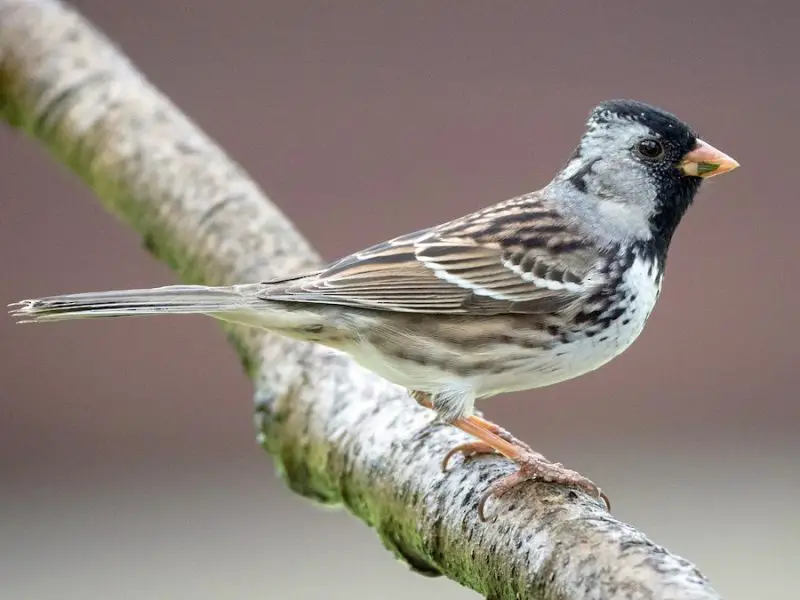
Harris’s Sparrow is the largest North American sparrow and a distinctive species with a bold black bib, face, and crown contrasting with its gray cheeks and nape. It has a pink bill, white underparts with some dark streaking on the sides, and brown-streaked upperparts.
Its song is a series of clear, high-pitched whistles that descend in pitch. Males sing from exposed perches during spring migration and are also heard giving sharp call notes in flocks. These sparrows forage on the ground and are known to scratch for seeds and insects under leaf litter.
Harris’s Sparrows are regular migrants and winter residents across Nebraska, especially in central and eastern parts of the state. They breed in the Canadian tundra but spend the nonbreeding season in shrubby fields, thickets, shelterbelts, and woodland edges throughout the Great Plains.
White-throated Sparrow (Zonotrichia albicollis)

The White-throated Sparrow is a striking bird, instantly recognizable by its crisp white throat patch, black-and-white striped crown, and bright yellow lores near the bill. Some individuals show a duller, tan-striped version, but both have gray underparts and brown-streaked backs.
Its song is a clear, whistled melody often interpreted as “Oh-sweet-Canada-Canada,” and it can be heard most often during spring and fall migration. This sparrow is often seen hopping along the ground or scratching through leaves in flocks, especially in wooded or brushy areas.
In Nebraska, White-throated Sparrows are common migrants in spring and fall and occasionally overwinter in the southeastern part of the state. They favor dense undergrowth, woodland edges, thickets, and backyard brush piles. Their diet includes seeds, berries, and insects during migration.
Sagebrush Sparrow (Artemisiospiza nevadensis) — Accidental

The Sagebrush Sparrow is a sleek, gray-headed sparrow with a white eye ring, dark mustache stripe, and white underparts streaked on the sides. Its upperparts are grayish-brown, and it shows a long tail with white edges. This species is built for blending into dry, open landscapes.
Its song is a short, dry, buzzy trill, repeated from exposed perches atop sagebrush or low shrubs. Unlike many sparrows, it often runs rather than hops when foraging and spends a lot of time on the ground. Its behavior is typically quiet and unobtrusive outside the breeding season.
In Nebraska, the Sagebrush Sparrow is considered accidental, with rare records in the far western panhandle. Its core habitat lies in the sagebrush steppe of the western United States. When it does appear in Nebraska, it’s usually during migration in open, arid, shrubby grasslands.
Vesper Sparrow (Pooecetes gramineus)

The Vesper Sparrow is a medium-sized sparrow with streaky brown plumage, a white eye ring, and a chestnut patch on the bend of each wing, which can be seen in flight. Its tail is long and white-edged, flashing noticeably when the bird takes off.
It is named for its beautiful, flute-like song, often delivered in the evening—hence the term “vesper.” The song includes clear whistles followed by a series of musical trills. These sparrows often sing from fence posts or small shrubs, especially in open country during spring and early summer.
In Nebraska, Vesper Sparrows are widespread summer residents, especially in open prairies, pastures, roadside edges, and cultivated fields. They nest on the ground and feed on grass seeds, grains, and insects. Their adaptability has allowed them to persist even in heavily farmed landscapes.
LeConte’s Sparrow (Ammospiza leconteii)
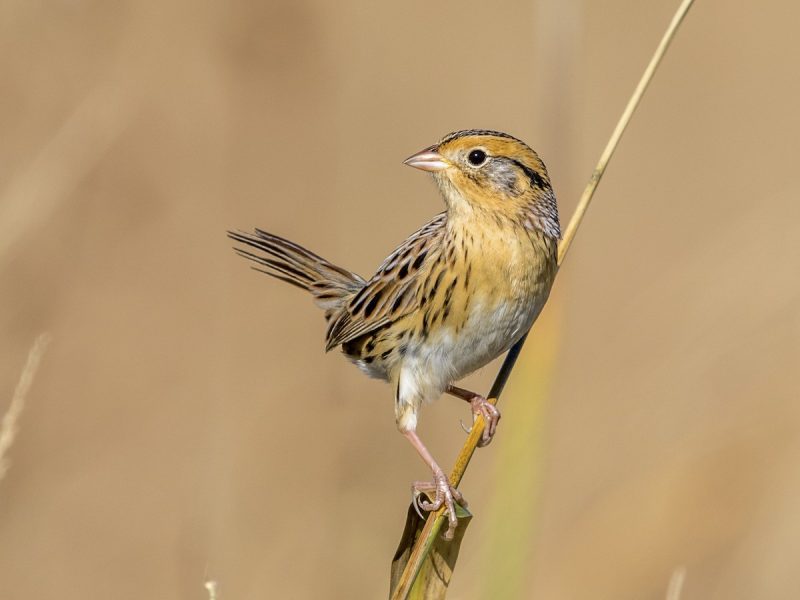
LeConte’s Sparrow is a tiny, secretive bird with a bright orange-buff face, gray nape, and fine streaks across its back and flanks. It has a very short tail and rounded body, giving it a compact appearance. It’s among the most beautifully colored but least often seen sparrows.
Its song is a thin, insect-like buzz, similar to a weak “tik-tik-zreee,” often heard at close range only. LeConte’s Sparrows are famously elusive—they freeze or creep through dense grass rather than fly, making them hard to observe. They often go undetected unless flushed or singing.
In Nebraska, LeConte’s Sparrows are uncommon migrants and very local summer breeders in wet meadows and tall grassy fields, mostly in the northern and eastern parts of the state. They depend on undisturbed, moist grasslands with dense ground cover for nesting and foraging.
Nelson’s Sparrow (Ammospiza nelsoni)
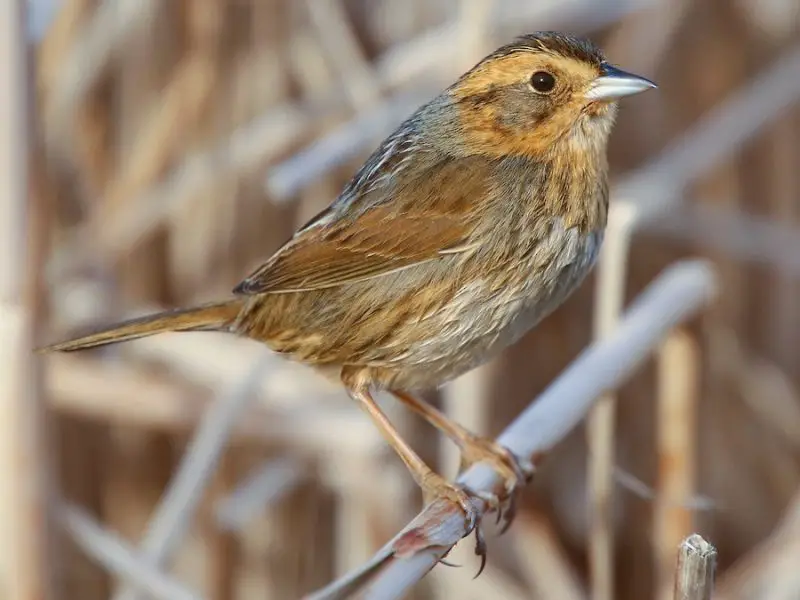
Nelson’s Sparrow is a beautifully marked sparrow with a warm orange face, gray cheeks, and finely streaked flanks. It has a short, spiky tail and a compact build, well-suited for life in thick marsh grasses. Its soft coloration helps it stay well camouflaged in its environment.
Its song is a quiet, insect-like hiss followed by a sharp note—much less musical than many other sparrows. These birds often sing at dawn and dusk and are more often heard than seen. Their secretive behavior makes them difficult to observe in the dense, wet habitats they prefer.
In Nebraska, Nelson’s Sparrow is an uncommon migrant, passing through during spring and fall. It is usually found in freshwater and brackish marshes, wet meadows, and grassy wetlands during migration. They feed on seeds and aquatic invertebrates gleaned from low vegetation or the water’s edge.
Baird’s Sparrow (Centronyx bairdii) — Accidental
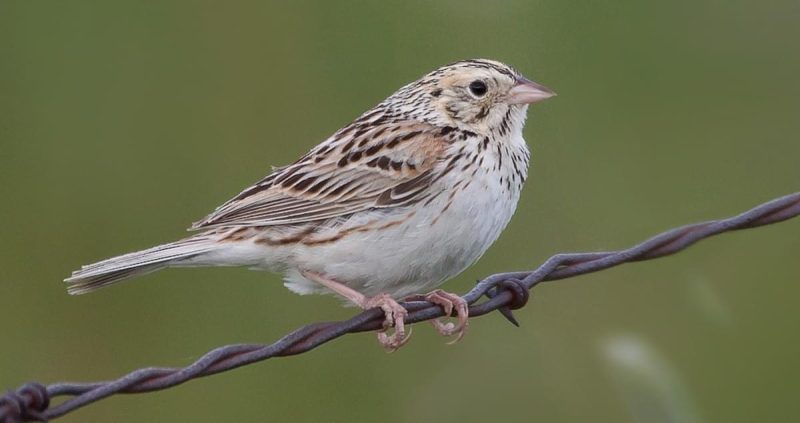
Baird’s Sparrow is a finely marked grassland bird with a pale buff face, dark crown stripes, and thin streaks on the chest that fade toward the belly. Its plumage blends beautifully into its grassy surroundings, with brown upperparts and a short, notched tail.
The bird’s song is a musical series of clear notes followed by short trills, often sung from tall grasses or low shrubs. Baird’s Sparrow is shy and secretive, typically staying low in dense vegetation and flushing only at close range. It is most often detected by sound during the breeding season.
In Nebraska, Baird’s Sparrow is considered accidental or very rare, with only a handful of documented sightings, usually in the western part of the state during migration. Its primary range includes native prairie in the northern Great Plains. Habitat loss due to agriculture makes it especially vulnerable.
Henslow’s Sparrow (Centronyx henslowii)
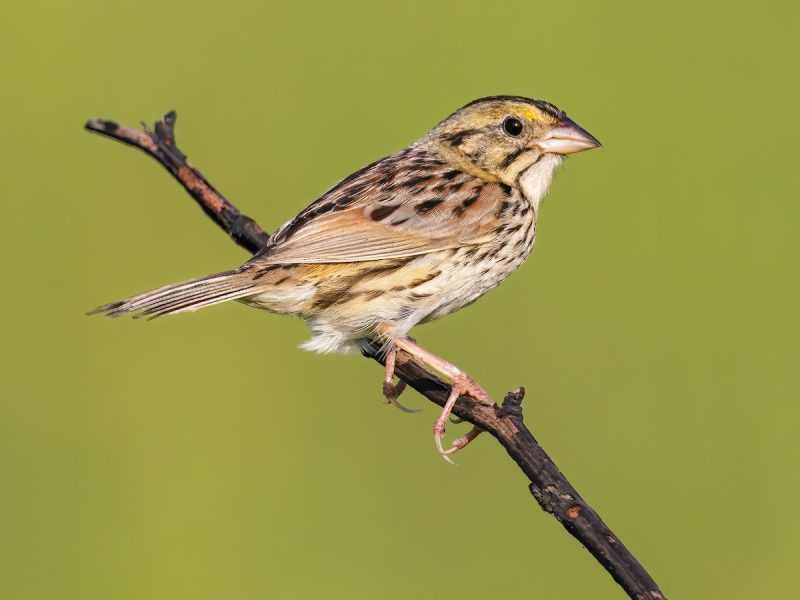
Henslow’s Sparrow is a small, flat-headed sparrow with a large head, short tail, and olive-green wash on the nape and face. It has fine streaks on the chest and flanks and two white wingbars. Its subtle coloration helps it stay concealed in tall grasses.
Its song is among the simplest of all North American sparrows—a dry, insect-like “tsi-lick” that is often delivered from a hidden perch in dense grassland. Henslow’s Sparrows are extremely secretive, moving low through the grass and rarely seen unless flushed.
In Nebraska, Henslow’s Sparrows are rare and local summer breeders, primarily in the southeastern portion of the state. They rely on tallgrass prairie and old fields with dense, undisturbed vegetation. Their diet includes insects during the breeding season and seeds in other months.
Savannah Sparrow (Passerculus sandwichensis)

The Savannah Sparrow is a medium-sized sparrow with a streaked brown back, white underparts with fine brown streaks, and a yellowish eyebrow (lore) in front of the eye. It has a short, notched tail and a slender bill. Despite being subtly marked, the yellow patch helps with identification.
Its song is a short, buzzy trill preceded by a few sharp notes, often heard from fence lines, grass tufts, or shrubs. This sparrow forages mostly on the ground and may form loose flocks during migration or in winter. It tends to flush with a sharp “tsip” call and a burst of rapid flight.
In Nebraska, Savannah Sparrows are common migrants and summer residents throughout much of the state, especially in grasslands, agricultural fields, and pastures. They nest on the ground and feed on insects and seeds, playing an important role in open grassland ecosystems.
Song Sparrow (Melospiza melodia)
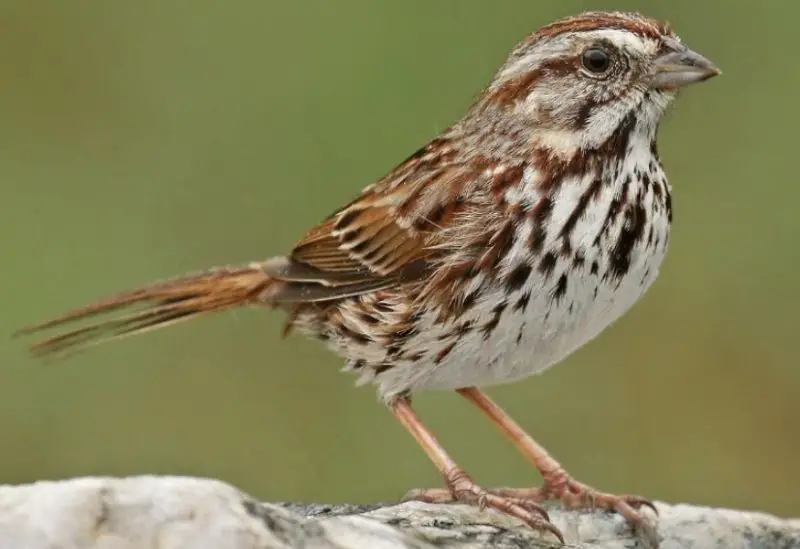
The Song Sparrow is one of the most familiar and widespread sparrows in North America. It is medium-sized with heavily streaked underparts and a distinctive dark central spot on the breast. Its head shows a grayish crown with brown stripes and a rounded tail.
True to its name, this sparrow has a beautiful, varied song of whistles, trills, and buzzes that is heard frequently during the breeding season. It also gives sharp “chimp” calls when disturbed. Song Sparrows are adaptable and often seen foraging near water, in brush piles, or around backyards.
In Nebraska, Song Sparrows are year-round residents in the east and widespread migrants across the state. They favor moist habitats like wetlands, stream edges, marshes, and thickets. Their diet includes insects, seeds, and berries, making them highly versatile foragers.
Lincoln’s Sparrow (Melospiza lincolnii)
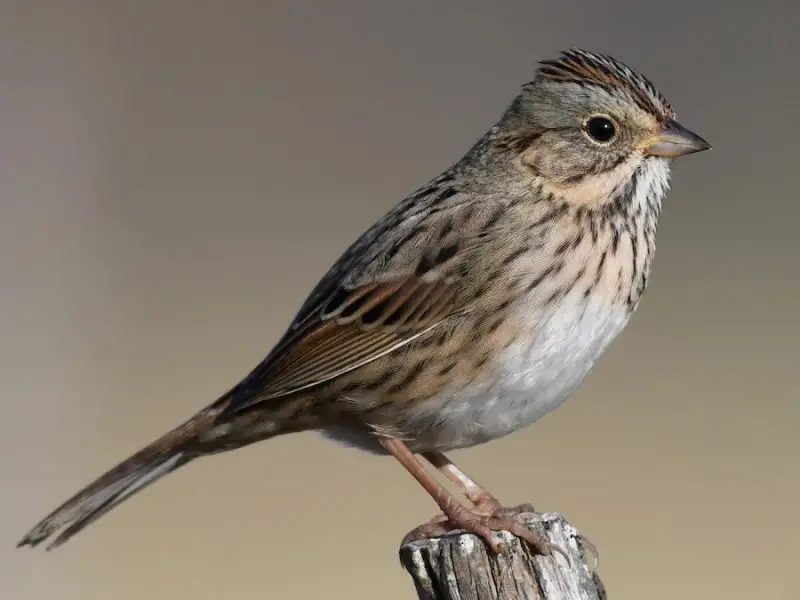
Lincoln’s Sparrow is a shy and elegant sparrow with a finely streaked breast, buffy mustache stripe, and gray face. It has a delicate, refined appearance, with subtle colors and crisp markings that help it blend into dense vegetation. Its crown is brown with a narrow gray central stripe.
Its song is a sweet, musical warble with buzzy and tinkling notes, often compared to the sound of a House Wren but more delicate. Lincoln’s Sparrows are elusive, usually foraging near the ground under dense cover and remaining still when approached.
In Nebraska, Lincoln’s Sparrows are primarily seen during spring and fall migration. They favor wet meadows, shrubby wetlands, and thickets along streams and field edges. Although they do not typically breed in the state, they are a regular and widespread migrant, feeding on insects and seeds.
Swamp Sparrow (Melospiza georgiana)
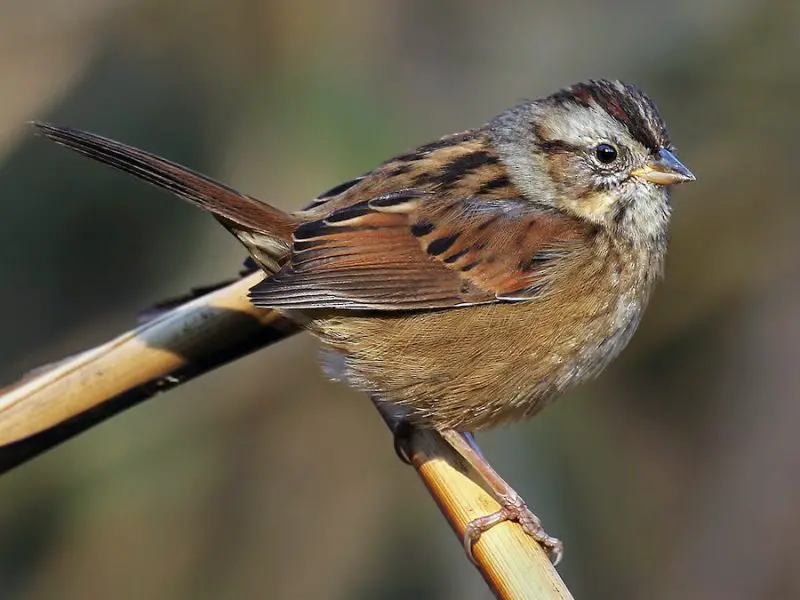
The Swamp Sparrow is a sleek, medium-sized sparrow with a rich rufous crown, gray face, and a dark eye line. Its back is streaked with brown and black, while the underparts are mostly gray with some rufous on the flanks. Its relatively long legs help it navigate through wet habitats.
This sparrow’s song is a slow, steady trill that resembles a musical insect buzz. Swamp Sparrows are secretive and often skulk in dense marsh vegetation, where they forage on the ground or just above the water line. Their call is a sharp “chip” often given when alarmed.
In Nebraska, Swamp Sparrows are common migrants and local breeders, especially in the eastern and northern parts of the state. They are strongly tied to wetlands—marshes, bogs, and wet meadows—and their diet includes seeds, aquatic invertebrates, and insects.
Green-tailed Towhee (Pipilo chlorurus)
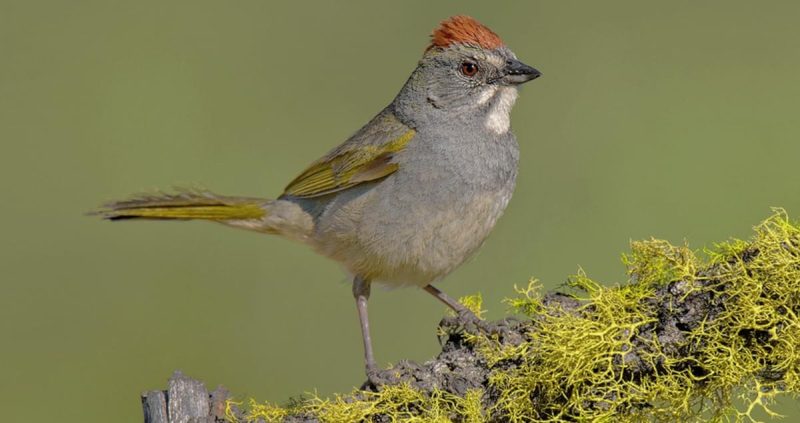
The Green-tailed Towhee is a large, colorful sparrow with an olive-green back and tail, gray body, and a striking rusty-red crown. It has white throat markings and dark streaks along its sides. Despite its vivid colors, it often stays hidden in brushy areas.
Its song is a sweet series of clear whistles and warbled phrases, somewhat similar to other towhees but with a more refined and musical tone. Green-tailed Towhees are shy and prefer thick cover, where they scratch in leaf litter for insects and seeds.
In Nebraska, this species is a rare migrant and occasional summer breeder in the western part of the state, especially in shrubby canyons and dry foothill habitats. Its secretive nature and preference for dense cover make it easy to overlook despite its beauty.
Spotted Towhee (Pipilo maculatus)
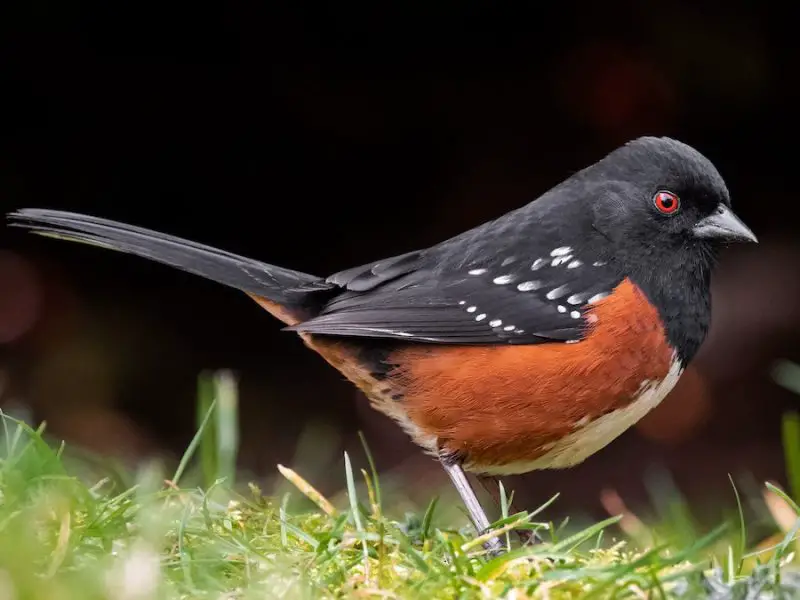
The Spotted Towhee is a striking bird with jet-black upperparts (in males), white spots on the wings and back, and rufous flanks. Females are similar but browner overall. Both sexes have red eyes and long tails edged in white, which they flick while foraging.
Their song is a sharp series of buzzy notes followed by a trill, and their call is a cat-like “mew.” Spotted Towhees forage by double-scratching the leaf litter, tossing debris aside in search of insects, seeds, and berries. They are bold in behavior but often stay in cover.
In Nebraska, Spotted Towhees are common in the western and central parts of the state, especially in shrubby prairies, forest edges, and brushy ravines. They are most often seen in spring and summer, though a few remain year-round in suitable western habitats.
Eastern Towhee (Pipilo erythrophthalmus)
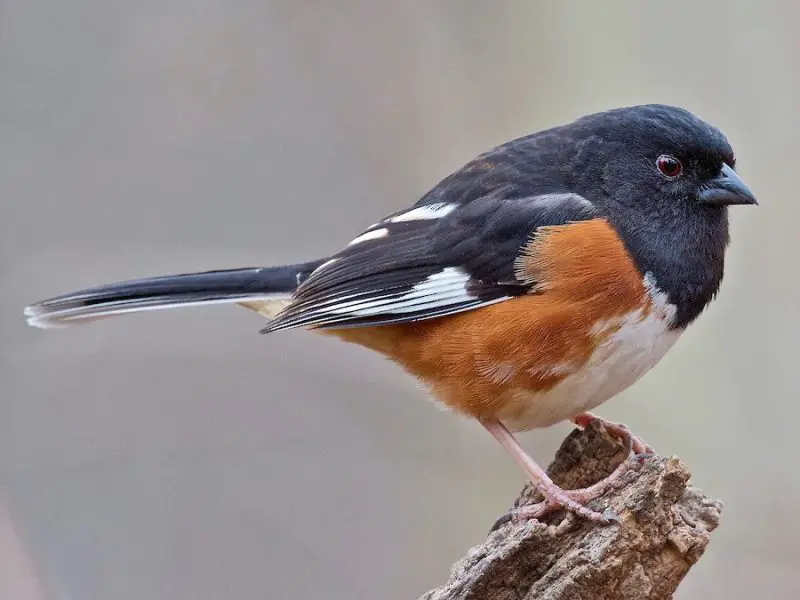
The Eastern Towhee is a large, eye-catching sparrow with a black hood and back (in males), rufous sides, and a white belly. Females are similar in pattern but have warm brown replacing the black. Both sexes have red eyes and long tails with white corners.
Their song sounds like “drink-your-tea,” a clear phrase followed by a trill, and they often give loud “chewink” calls. Like their western relatives, they forage by kicking leaf litter aside with both feet, hunting for insects, seeds, and fruit near the ground.
In Nebraska, Eastern Towhees are found mostly in the eastern and southeastern regions during spring and summer. They inhabit forest edges, thickets, and overgrown clearings. They are less common than Spotted Towhees in the state but can be locally abundant in dense shrubby areas.

